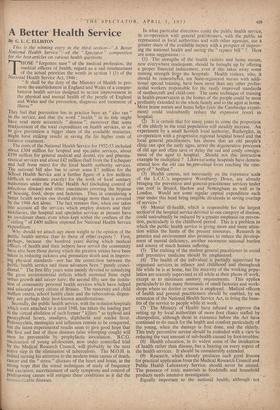A Better Health Service
By G. L: C. ELLISTON This is the winning entry in the third section—" A Better National Health Service "—of the " Spectator" competition for the best.articles on various health questions.
THOSE " forgotten men " of the medical, profession, the medical officers of health, regard as a sad misstatement of the actual priorities the words in section 1 (1) of the National Health Service Act, 1946: " It shall be the duty of the Minister of Health to pro- mote the establishment in England'and Wales of a compre- hensive health service designed to secure improvement in the physical and mental health of the people of England and Wales and the prevention, diagnosis and treatment of i Ilness."
They feel that prevention has in practicebeen an " also ran " in the service, and that the word " health " in its title might have read more accurately " disease "; moreover that some readjustment of the total expenditure on health services, seas to give prevention a bigger share of the available resources. might have striking result in saving the far higher costs of curative treatment.
The costs of the National Health Service for 1952-53 included about £304 million for hospital and specialist services, about £199 million for general medical and dental, eye and pharma- ceutical services and about £42 million (half from the Exchequer and half from rates) for the local health authority services. The national bill also has to cover. some £7 million for the School Health Service and a further figure of a few millions (difficult, to 'estimate exactly) for the work of local sanitary authorities under the Public Health Act (including control of infectious disease) and other enactments covering the hygiene of housing, food, shops and factories. Thus in considering a better, health service one should envisage more than is covered by the 1946 Act alone. The fact remains that, when one takes into account all the services which .employ doctors and their auxiliaries, the hospital and specialist service at present have a, n inordinate share, even when-kept within the confines of the ' ceiling " of £400 million imposed for National Health Service expenditure. .
Why should we attach any more weight to the opinion of the public health service than to those of other experts ? First, perhaps, because the hundred years during which medical officers of health and their helpers have served the community have also been those during which the greatest strides have been taken in reducing sickness and premature death and in improv- ing physical standards--nor has the connection between the Public health service and these advances been " purely coinci- dental." The first fifty years were mainly devoted to remedying the gross environmental defects which stemmed from rapid urban growth and laisser faire; the second fifty saw the institu- tion of community personal health services which have helped and educated every citizen of Britain. The maternity and child welfare centre, school health clinic and the tuberculosis dispen- sary are perhaps their best-known manifestations. Secondly, the public health service, with the isolation hospitals which were attached to it until 1948, has taken the leading part in the virtual abolition of such 'former " killers " as typhoid and Paratyphoid fevers, smallpox, diphtheria and scarlet fever. Poliomyelitis, meningitis and influenza remain to be conquered, but the latest experimental results seem to give good hope that the first and last of these diseases (also whooping cough) will soon be preventable by prophylactic inoculation. B.C.G. vaccination of young adolescents, now under controlled trial by the Medical Research Council, will probably be the next active step in the elimination of tuberculosis. The M.O.H..is indeed turning his attention to the modern main causes of death, cancer and the 4 stress " diseases of the heart and brain, in the strong hope that the sound techniques of study of frequency and causation, ascertainment of early symptoms and control of predisposing causes will mitigate these conditions as it did the communicable diseases. In what particular directions could the public health service, in co-operation with general practitioners, with the public as represented in local authorities and with other agencies, use a greater share of the available money with a prospect of improv- ing the, national health and saving the repairs bill " ? Here are some suggestions : — (1) The strengths of the- health visitors and home nurses, now everywhere inadequate, should be brought up by offering a proper financial inducement, even if this takes away some nursing strength frop the hospitals. Health visitors, who, it Should be remembefed, are State-registered nurses with addi- tional special training, have been more than any other profes- sional workers responsible for the vastly improved standards of mothercraft and child-care. The same technique of training in health-preservation in the homes of the people could be most „ profitably &tended to the whole family and to the aged at home. More home nurses and home helps (vide the Cambridge experi- ment) could undoubtedly reduce the expensive resort to hospital.
(2) It is certain that for many years to come the proportion of the elderly in the total population will steadily increase. An experiment by a small Scottish local authority, Rutherglen, in co-operation with a progressive regional hospital board and the local general practitioners, has shown that an old people's clinic can spot the early signs, arrest the degenerative processes of old age and often save or delay the sad and costly consign- ment of the aged to hospital. Should not this instructive example be multiplied ? Likewise some hospitals have demon- strated how the old can be prevented From reaching the cate- gory of " bedfast." (3) Health' centres, not necessarily on the expensive scale' of the L.C.C.'s impressive Wood berry Down, are already bringing the preventive and general-practitioner services under one roof in Bristol, Harlow and Nottingham as well as in London. Would not some regular capital expenditure each year under this head bring tangible dividends in saving overlap of services ?
(4) Mental ill-health, which is responsible for the largest section'of the hospital service devoted to one category of disease, could undoubtedly be reduced by a greater emphasis on preven- tion, particularly in the childhood period. This is a problem to which the public health service is giving more and more atten- tion within the limits of the present resources. Research in genetics and environment also promises to reduce the develop- ment of mental deficiency, another enormous national burden and source of much human suffering. • (5) The training of the student- general practitioner in social and preventive medicine should be emphasised. (6) The health of the individual is partially supervised by organised services. in infancy and childhood and throughout life while he is at home, but the majority of the working popu- lation are scarcelyssupervised at all while at their places of work, except as to minimum sanitary requirements. This applies particularly to the ,many thousands of small factories and work- shops where no doctor or nurse is employed. Medical officera. of health and general practitioners should be enabled,, by an extension of the National Health Service Act, to bring the bene- fits of the service to people while at work. (7) The Ministry of Health have refused to approve the setting up by- local authorities of more foot clinics staffed by . chiropodists, although those in existence before the Act have continued to do much for the health and comfort particularly of the young, when the damage is first done, and the elderly. This truly preventive service should be extended with a view'to reducing the vast amount of sub-health caused by foot-troubles. (8) Health education, in its widest sense of the inculcation of health rather than disease, has a 'bearing on every aspect of the health services. It should, be considerably extended.
(9) Research, which already produces such good lessons for practical application from the Medical Research Council and , Public Health Laboratory Service, should, never be stinted. The presence of toxic materials in foodstuffs and household products needs intensive investigation. Equally important to the national health, although not perhaps strictly within the scope of the National Health Service Act, are the following : (10) Man-made smoke in the Greater London fog of December, 1952, hastened the deaths of some 4,000 persons, over and above the normal deaths to be expected, and filled the hospitals with acutely distressed patients. (Com- pare this with the death-roll of about 300 caused by the East Coast inundations.) It is known beyond doubt that respiratory 'illness, especially in the very young and the old, is perpetually aggravated by the chronic smoke nuisance arising from the burning of raw coal, particularly in domestic grates, not to mention the damage to buildings and fabrics. Should not all urban authorities be given flower to enforce " smokeless zones" at once ? So far only Coventry and Manchester have been enabled to make a start, but Salford failed to get approval by the Minister of Housing and Local Government to order such a zone, presumably on the grounds of short supply of smokeless fuels. Are the Ministers concerned really doing all that could be done about this aspect of our environment ? (11) Careful American work already in progress for eight years has shown that the provision of a water-supply with a fluorine content of one part per million has surprising results in improving the dental condition of children who get this water- supply from birth. So far the Ministry of Health has refused to approve proposals by local authorities which wished to follow this course in England and Wales. The cost of adding fluorine where necessary is estimated at not more than ls. per head per year. Compared with that of dental disease and repair, is not this a logical and economical preventive measure ?



































 Previous page
Previous page